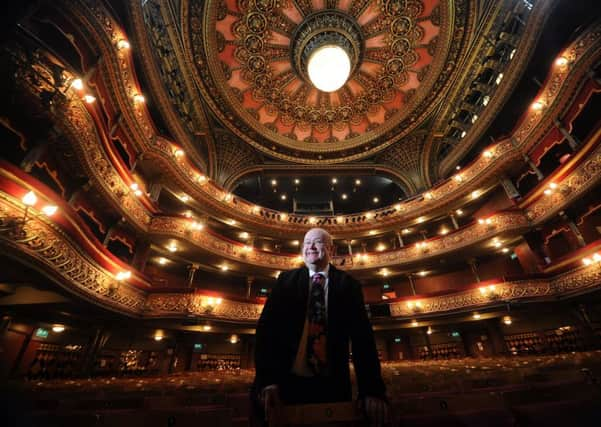Leeds Grand Theatre marks 140 years


This weekend Leeds Grand, or the Grand Old Lady of Leeds as the theatre is sometimes affectionately referred to, will be 140 years old and the anniversary is being celebrated over the next two weeks, starting on Sunday with a pop-up photo exhibition at Victoria Gate in the city, followed by a red carpet event at the theatre in collaboration with the Broadway musical, Jersey Boys.
Leeds Grand is at the heart of the city’s cultural life and has been for many years. People have met there and fallen in love there and it remains one of the most prestigious theatres in the North of England.
Advertisement
Hide AdAdvertisement
Hide AdIts origins have a royal connection. The theatre was built in 1878, reportedly following an off-the-cuff remark by Prince Albert that Leeds needed a good theatre as “nothing was more calculated to promote culture and raise the tone of the people”.
The Grand was designed during a backlash against the so-called “common” entertainment of the music halls, yet it was felt there was also a big enough demand to sustain the opening of the Empire and Theatre Royal.
From his Grand Tour of Europe, architect’s assistant James Robertson Watson returned with sketches of theatre interiors in Italy, France and Germany, presented them to his boss, George Corson, and the eclectic Grand emerged.
They adapted Romanesque and Gothic motifs and the church-like echoes of helped underline that this was a respectable place of entertainment.
Advertisement
Hide AdAdvertisement
Hide AdIt then took 13 months to complete at a cost of £62,000, and also included six shops, Assembly Rooms, a supper room and large cellars.
The theatre itself (now a Grade II* listed building) was described at the time as being “ahead of its time” and “probably the finest of its size in Britain.”
A treasured playbill survives from the Grand’s opening night on November 18, 1878, starring actor-manager and playwright Wilson Barrett.
“He had his own theatre company and was commissioned to open the venue and the very first production was Much Ado About Nothing,” says Ian Sime, the theatre’s general manager.
Advertisement
Hide AdAdvertisement
Hide Ad“It was the largest theatre in the area and at the time a lot of theatres were built close to railway stations to bring audiences into Leeds and make it easy to take them back home again. But also a lot of the sets used to be brought in by train and then horse-drawn carriage.”
Back then a box cost two guineas, and it was a shilling to stand in the pits.
Later they became stalls with benches, and until the 1920s “packers” were employed, aggressive characters who were specialists in the art of maximising seating capacity through pushing and shoving.
The Victorians demanded spectacle from their shows and the Grand’s complex stage machinery was designed to deliver it with a series of traps and bridges which could be used for elaborate transformation scenes.
Advertisement
Hide AdAdvertisement
Hide AdMany of the brightest stars made their way to Leeds, including Sarah Bernhardt, Henry Irving and Lily Langtry. But it was panto which made the serious money.
The panto crowds outside the theatre were so dense they held up the horse trams.
Its popularity continued into the new century. During the First World War it, like the nearby City Varieties, was used as a recruiting venue to encourage young men to sign up.
Productions continued to be put on during the Second World War. “There would be an announcement made if there any air raids and people had the option of leaving or going to the cellars underneath the theatre which were converted into air raid shelters,” says Sime.
Advertisement
Hide AdAdvertisement
Hide AdAfter the war the Grand continued to attract big plays. “We were one of the first places to show The Mousetrap before it went to the West End.” This was back in 1952 when Richard Attenborough and his wife Sheila Sim were among the original cast.
Over the years the theatre has played to such stellar names as Laurence Olivier, Margot Fonteyn, Peter O’Toole, Sean Connery, Julie Andrews, Peter Ustinov and, more recently, Peter Kay and Sting.
“We have a visitors book which dates back to 1945 and has got many of the great show business names. There’s Morecambe and Wise, Bruce Forsyth and Noel Coward. And it’s always been that kind of venue, the premier receiving house in Yorkshire,” says Sime.
“It’s still a successful working theatre so it’s far from a museum and it’s a venue that is busy throughout the year. It has productions for people of all tastes and all occasions and we’ve had big shows playing here before going to the West End.”
Advertisement
Hide AdAdvertisement
Hide AdIt’s also seen high profile premieres such as Calendar Girls The Musical and Kay Mellor’s Fat Friends The Musical,
“People have taken the Grand Theatre to their heart and it’s seen as a bit like Yorkshire’s answer to the London Palladium because it is a great of entertainment for ordinary people,” says Sime.
“Our dear friend Ken Dodd turned round to me once and said, ‘young man, you put on entertainment at this theatre.’ And coming from him that was a wonderful compliment.”
It certainly was.
Theatre almost closed in Sixties
In March 1969, Leeds Council discussed pulling down the theatre and putting up a 22-storey office block.
Advertisement
Hide AdAdvertisement
Hide AdThen just before Christmas the council agreed to take a lease for a minimum of seven years and arranged for a trust to operate the theatre.
The council, together with the Arts Council, would underwrite the theatrical operation. Three years on, at the end of July 1973, Leeds Council bought the Grand and the adjoining property for about £355,000.
It was a wise investment.